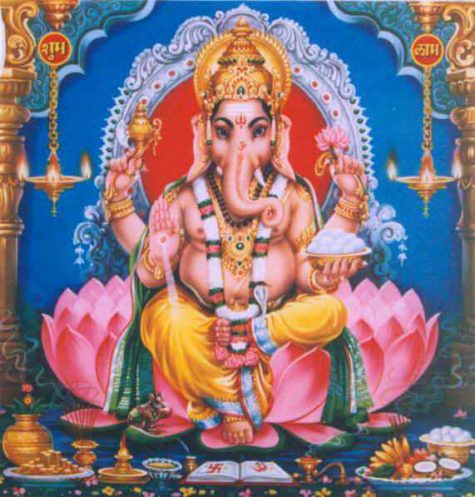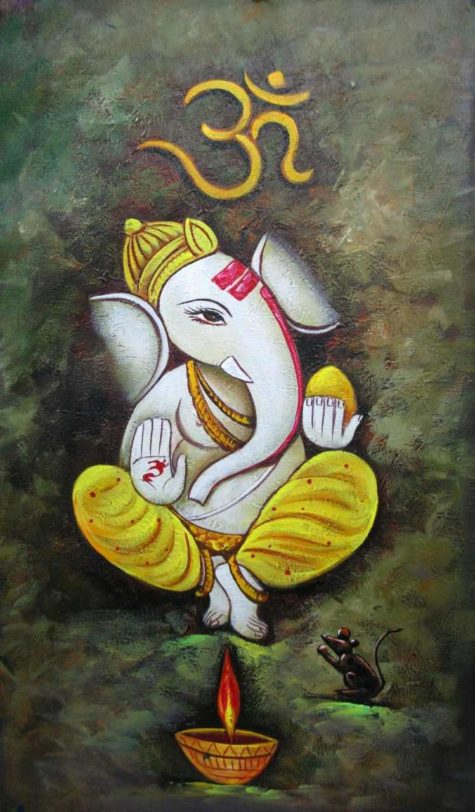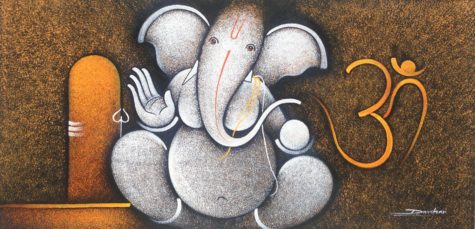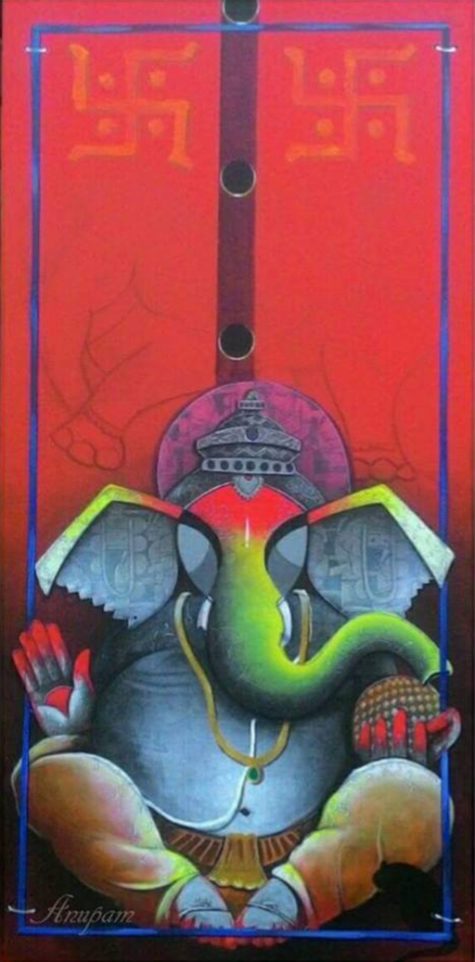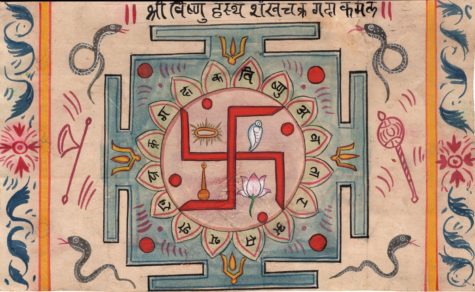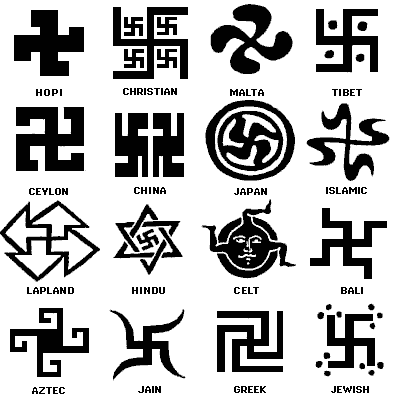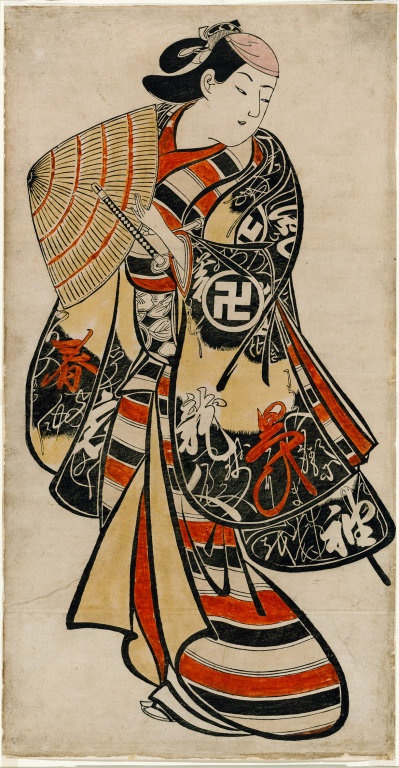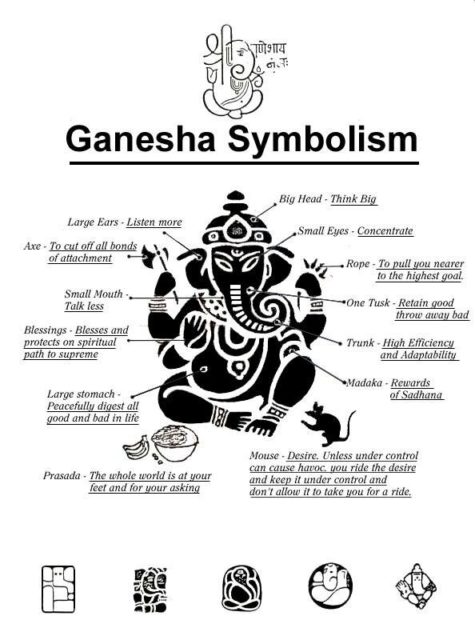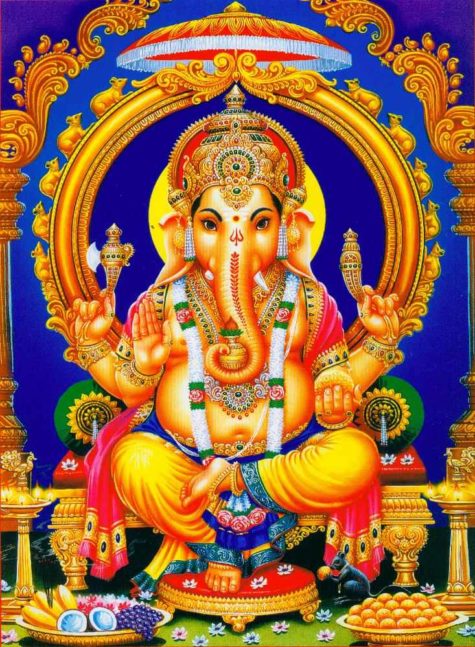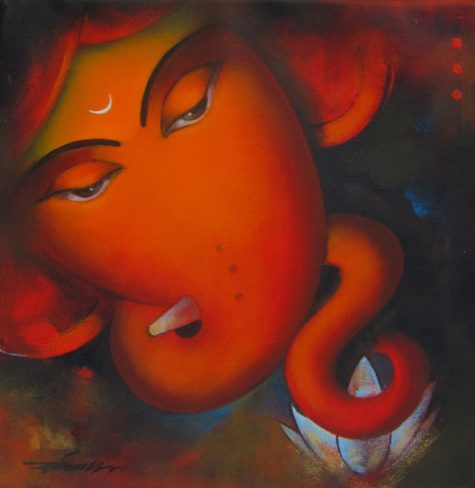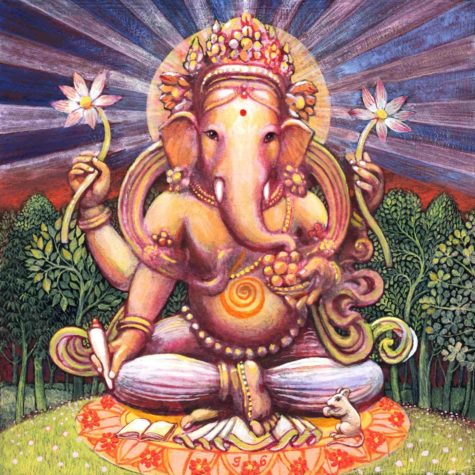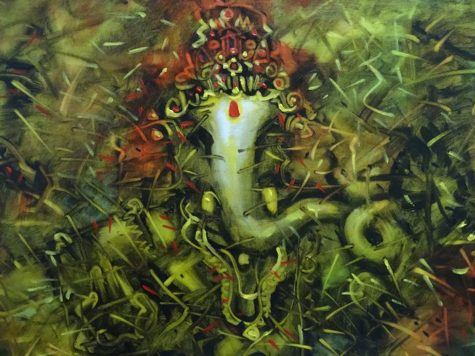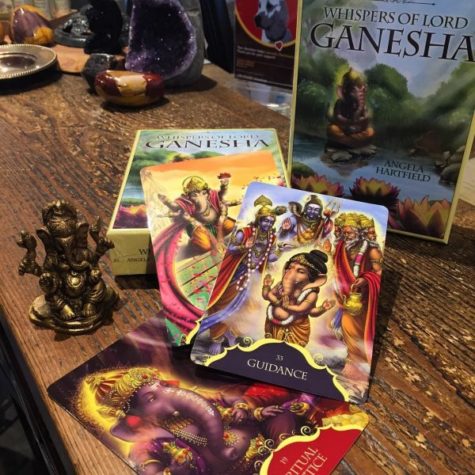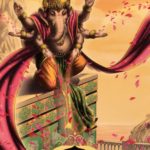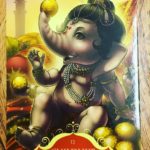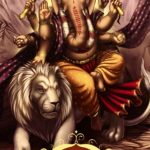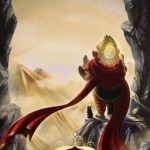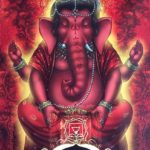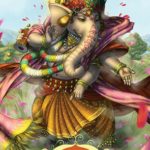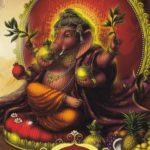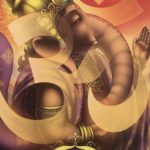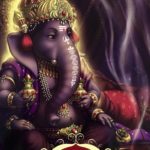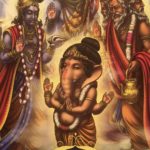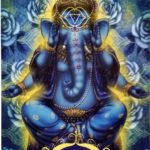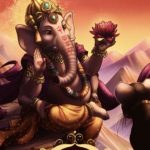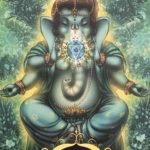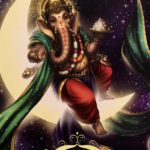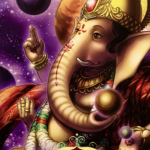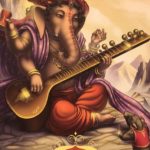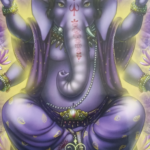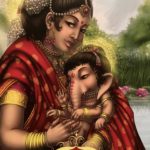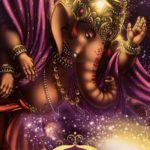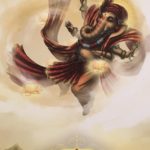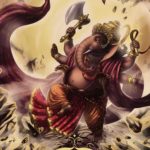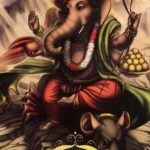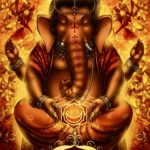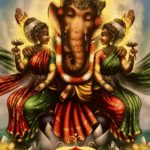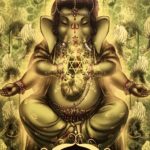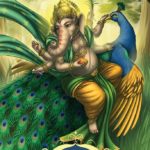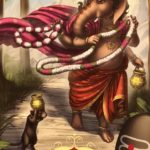Invoking Ganesh
Gan Ganpataye Namo Namah
Om Gan Ganapataye Namo Namah
Shree Siddhi Vinayak Namo Namah
Shree Ashtavinayak Namo Namah
Ganapati Bappa Moraya
We ask for good fortune and many blessings and wishes for our current life and future lives. We bow in Homage to Lord Ganesha who blesses us with long lives, health and happiness.
Here is:
Ganesh Mantra by Suresh Wadkar | Om Gan Ganpataye Namo Namah – 108 times with Meaning:
Sixteen Names of Ganesha
If you recite and/or listen to these sixteen names at the beginning of studies, at the time of marriage, while entering or departing a place, or at the battle field, all your obstacles will be removed.
Sumukhascha Ekadanthascha
Kapilo Gajakarnakaha
Lambodarascha Vikato
Vighnaraajo Ganaadhipaa
Meaning: The various names and associated forms of God Ganesha are enumerated and need to be meditated upon here – the one with an auspicious face, the single tusked Lord, the one who is of red color, the one with the ears of an elephant, the one with a big stomach, the one with a jovial disposition, the controller of obstacles, the Lord of the Ganas.
Dhoomaketur Ganaadhyashah
Phaalachandro Gajaanana
Vakratundo Shoorpakarno
Heyrambho Skandapoorvajaha
Meaning: The one of smoke gray color, the leader of the ganas, the one who has moon in the front of his forehead, the elephant faced one, the one with a curved trunk (or broken tusk), the one with big (basket like) ears, the one who is heroic like a buffalo, the elder brother of Skanda (Skanda is another name for Lord Subrahmanya)
Shodashaitaani Namaani
Yah Pateth Srunuyaadapi
Vidyaarambhe Vivahe Cha
Praveshey Nirgamey Tatah
Sangraamey Sarva Kaaryeshu
Vighnas Tasya Na Jaayathe
Abheepsitaartha Siddhyartham
Poojitoya Surairapi
Sarva Vighna Chhido Tasmai
Sree Ganaadhipataye Namaha
Meaning: Whoever the one who recites and listens to these sixteen names at the beginning of studies, at the time of marriage, while entering or departing a place, or at the battle field, all their obstacles will be removed. Even the Gods worship Lord Ganesha to receive the fulfillment of their actions. Oh Lord Ganesh, the One who has this power of destroying all the obstacles in the way of the devotees, I prostrate before you.
From: Saidarshan.org
Twelve Names of Ganesha
We already explored the 108 names of Ganesh, but these twelve names are in the form of a shloka, which is a verse, proverb, hymn or poem that uses a specific meter. This group of verses is said to be sage Narada’s offering to Lord Ganesh. So, if you like doing these Sanskrit chants, here are some more. I think this is meant to be recited in its entirety, rather than bits and pieces.
Pranamya Shirasa Devam
Gauriputram Vinaayakam
Bhakataavaasam Smare Nityam
Aayuh Kaamartha Siddhaye
Meaning: Every day, I bow down to that Lord, the son of Gowri, the Lord one who lives in the heart of the devotees, blessing them always with good health and prosperity.
Prathamam Vakratundam Cha
Ekadantam Dviteeyakam
Thriteeyam Krishna Pingaaksham
Gajavaktram Chaturthakam
Meaning: Starting from here the twelve names of Ganesha are mentioned and he is worshiped in those different forms. The first as the Lord with the curved trunk; second, as the one with only one tusk, third, as the one with black (red/brown) eyes, fourth, as the one with giant structure.
Lambodaram Panchamaam Cha
Shashtam Vikatameva Cha
Saptamam Vighnaraajendram
Dhoomravarnam Tathaashtamam
Meaning: Fifth, as the one with a big (long) stomach, six, as the one with a huge body Seven, as the remover of obstacles, eight, as the one with smoke gray color
Navamam Phaalachandram Cha
Dasamam Tu Vinaayakam
Ekaadasam Ganapatim
Dvaadasam Tu Gajaananam
Meaning: Ninth, as the one with moon on the front of His head, tenth, as the foremost leader, eleventh, as the leader of the ganas, twelfth as the one with elephant face.
Dvaadasaitaani Naamaani
Trisandhyam Yah Pathernnarah
Na Cha Vighna Bhayam Tasya
Sarva Siddhikaram Prabho
Meaning: Any person, who remembers these twelve names of Ganesha, three times in a day, will have all their obstacles and fear removed and will attain success.
From: Saidarshan.org
Shlokas on Lord Ganesha
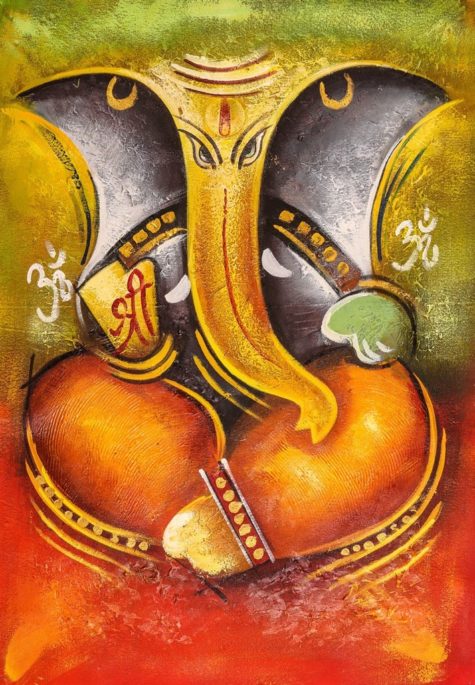
What is a Shloka?
Shloka is a Sanskrit word referring to a verse, proverb, hymn or poem that uses a specific meter. It is considered as the classic basis for epic Indian poetry as its use is widespread in traditional Sanskrit poems. Among the famous texts written entirely in shlokas are the “Ramayana” and “Mahabharata.”
Technically, a shloka can be made up of any sort of four-line stanza with up to 26 letters in a single line. In terms of yoga practice, it is likely that a yogi who meditates will come across this classical form of verse in the mantras that can help one meditate effectively.
Shlokas on Lord Ganesh:
Shuklaambara Dharam Vishnum
Shashi Varnam Chatur Bhujam
Prasanna Vadanam Dhyaayet
Sarva Vighna Upashaanthaye
Meaning: We meditate on Lord Ganesha – who is clad in white (representing purity), who is all pervading (present everywhere), whose complexion is gray like that of ash (glowing with spiritual splendor), who has four arms, who has bright countenance (depicting inner calm and happiness) and who can destroy all obstacles (in our spiritual and worldly path).
Vakratunda Mahakaaya
Suryakoti Samaprabha
Nirvighnam Kuru Mey Deva
Sarva Kaaryeshu Sarvada
Meaning: The Lord with the curved trunk and a mighty body, who has the luster of a million suns, I pray to thee Oh Lord, to remove the obstacles from all the actions I intend to perform.

Agajaanana Padmaarkam
Gajaananam Aharnisham
Anekadantham Bhaktaanaam
Ekadantam Upaasmahey
Meaning: I worship day and night that elephant faced Lord Ganesha who is like sun to the lotus face of Mother Parvati. Giver of many boons, the single tusked Ganesha, I salute Thee to give me a boon.

Gajaananam Bhoota Ganaadhi Sevitam
Kapitta Jamboophaala Saara Bhakshitam
Umaasutam Shoka Vinaasha Kaaranam
Namaami Vighneswara Paada Pankajam
Meaning: The Lord with the elephant face, served by all the Ganas, One who takes as His food, the essence of Kapitta and Jamboophala (these are two favorite fruits of Ganesha), son of Uma (Mother Parvati), destroyer of misery of the devotees, controller of obstacles, we worship Your Lotus Feet.

Ganaanaam Twam Ganapathi Gam Havaamahe
Kavim Kaveenaam Upamasra Vastamam
Jyeshta Raajam Brahmanaam Brahmanaspatha
Aanashrunvanna Oothibhi Seedha Saadanam
Meaning: We invite You, the Lord of spiritual faith (of Lord Shiva). You are the wisest among the wise, the best to be given as a standard of comparison. You are the senior Lord, Lord of the Vedic mantras, listening to our prayers. Please visit our home with prosperous things and be seated here.
Tatpurushaaya Vidmahe
Vakratundaaya Dheemahe
Tanno Danthihi Prachodayaat
Meaning: We meditate on that super power, we invoke the single tusked boon giver, Ganesha.

GANESHA PANCHARATNAM
Mudakaraatha Modakam Sada Vimukti Saadhakam
Kalaadharaavatamsakam Vilasiloka Rakshakam
Anaaya Kaika Naayakam Vinasitebha Daityakam
Nataasubhasu Naashakam Namaami Tham Vinaayakam.
Meaning: I prostrate before Lord Vinaayaka who joyously holds modaka in His hand, who bestows salvation, who wears the moon as a crown in His head, who is the sole leader of those who lose themselves in the world. The leader of the leaderless who destroyed the elephant demon called Gajaasura and who quickly destroys the sins of those who bow down to Him, I worship such a Lord Ganesha.

Natetaraati Bheekaram Navoditaarka Bhaasvaram
Namat Suraari Nirjanam Nataadhi Kaapa Duddharam
Suresvaram Nidheesvaram Gajesvaram Ganeshvaram
Mahesvaram Samaasraye Paraatparam Nirantaram.
Meaning: I meditate eternally on Him, the Lord of the Ganas, who is frightening to those not devoted, who shines like the morning sun, to whom all the Gods and demons bow, who removes the great distress of His devotees and who is the best among the best.

Samasta Loka Samkaram Nirasta Daitya Kunjaram
Daredarodaram Varam Vare Bhavaktra Maksharam
Krupaakaram Kshamaakaram Mudaakaram Yasaskaram
Manaskaram Namaskrutaam Namaskaromi Bhaasvaram.
Meaning: I bow down with my whole mind to the shining Ganapati who brings happiness to all the worlds, who destroyed the demon Gajasura, who has a big belly, beautiful elephant face, who is immortal, who gives mercy, forgiveness and happiness to those who bow to Him and who bestows fame and a well disposed mind.

Akimchanaarti Marjanam Chirantanokti Bhaajanam
Puraari Poorva Nandanam Suraari Garva Charvanam
Prapancha Naasha Bheeshanam Dhananjayaadi Bhushanam
Kapola Daana Vaaranam Bhajaey Puraana Vaaranam.
Meaning: I worship the ancient elephant God who destroys the pains of the poor, who is the abode of Aum, who is the first son of Lord Shiva (Shiva who is the destroyer of triple cities), who destroys the pride of the enemies of the Gods, who is frightening to look at during the time of world’s destruction, who is fierce like an elephant in rut and who wears Dhananjaya and other serpents as his ornaments.

Nitaantikaanta Dantakaanti Mantakaanta Kaatmajam
Achintya Rupa Mantaheena Mantaraaya Krintanam
Hrudantarey Nirantaram Vasantameva Yoginam
Tameka Danta Meva Tam Vichintayaami Santatam.
Meaning: I constantly reflect upon that single tusked God only, whose lustrous tusk is very beautiful, who is the son of Lord Shiva, (Shiva, the God of destruction), whose form is immortal and unknowable, who tears asunder all obstacles, and who dwells forever in the hearts of the Yogis.

Mahaaganesa Pancharatnam Aadarena Yonvaham
Prajapati Prabhaatake Hrudi Smaran Ganesvaram
Arogatham Adoshataam Susaahitim Suputrataam
Samaahitaayu Rastabhootim Abhyupaiti Sochiraat.
Meaning: He who recites this every morning with devotion, these five gems about Lord Ganapati and who remembers in his heart the great Ganesha, will soon be endowed with a healthy life free of all blemishes, will attain learning, noble sons, a long life that is calm and pleasant and will be endowed with spiritual and material prosperity.
From: Saidarshan.org
About The Swastika Symbol
The swastika has been regarded as the symbol for good luck, protection and auspiciousness for over five thousand years in India. It is derived from ‘SU-VASTI’ and means “The essence of all goodness”. For Hindus the swastika is a lucky cross associated with the good fortunes given by Lord Ganesha. It also represents the sun and the cycle of life.
This ancient benign symbol is used today by housewives to guard thresholds and doors, by priests to sanctify ceremonies and offerings and by businessmen to bless the opening pages of account books each New Year’s day. No ceremony or sacrifice is considered complete without it, for it is believed to have the power to ward off misfortune and negative forces.
It is said that the swastika’s right-angled arms reflect the fact that the path toward our objectives is often not straight, but takes unexpected turns. They denote also the indirect way in which Divinity is reached — through intuition and not by intellect. Symbolically, the swastika’s cross is said to represent God and creation.
The four bent arms stand for the four human aims:
- Righteousness – dharma
- Wealth – artha
- Love – kama
- Liberation – moksha.
It also represents the world wheel, eternally turning around a fixed center, God. The swastika is associated with the muladhara chakra, the center of consciousness at the base of the spine, and in some yoga schools with the manipura chakra at the navel, the center of the microcosmic sun (surya).
The swastika is a sacred sign of prosperity and auspiciousness, perhaps the single most common emblem in earth cultures. As the Encyclopaedia Britannica explains, “It was a favorite symbol on ancient Mesopotamian coinage; it appeared in early Christian and Byzantine art (where it became known as the gammadion cross because its arms resemble the Greek letter gamma); and it occurred in South and Central America (among the Mayans) and in North America (principally among the Navajos). In India it continues to be the most widely used auspicious symbol of Hindus, Jainas and Buddhists.”
When Buddhism emerged from India’s spiritual wellspring, it inherited the right-angled emblem. Carried by monks, the good-luck design journeyed north over the Himalayas into China, often carved in statues into Buddha’s feet and splayed into a spectrum of decorative meandering or interconnecting swastikas.
On the other side of the planet, American Indians inscribed the spoked sign of good luck into salmon-colored seashells, healing sticks, pottery, woven garments and blankets. Two thousand miles south, the Mayans of the Yucatan chiseled it into temple diagrams.
Once moored to the ancient highland cultures of Asia Minor, the emblem later voyaged around the Mediterranean, through Egypt and Greece, south into the African nations, northward into Saxon lands and Scandinavia and west to Scotland and Ireland.
In the 1930s, when Adolf Hitler’s Nazi Third Reich rose to power in Germany and engulfed the planet in World War II, the fortunes of the swastika declined. From September 1935 to the fall of the Nazis in 1945 it was displayed on the Reich’s official flag, a black swastika in a white circle against a red field. German soldiers also wore the hackenkrenz (“hooked cross”) on their uniforms, in a circle beneath an eagle, and displayed it on their armory. In the West it became an infamous, hated symbol of fascism and anti-Semitism and was banned by the Allied Command at the war’s end, though the swastika’s history is as extensive in the West as in Asia.
Because of its infamous association with the Third Reich, the swastika was and still is abhorred by many inside and outside of Germany, still held in disparagement and misunderstanding, which itself is understandable though unfortunate. Now is a time for this to change, for a return to this solar symbol’s pure and happy beginnings. Ironically, even now Hindus managing temples in Germany innocently display on walls and entryways the swastika, the ancient symbol of Lord Ganesha and more recently the hated insigne of Nazism, alongside the shatkona, six-pointed star, the ancient symbol representing God Siva and Lord Karttikeya and as Star of David, the not so ancient but cherished already for centuries emblem of Judaism.
The swastika is an emblem of geometric perfection. In the mind’s eye it can be stable and still or whirl in perpetual motion, its arms rotating one after another like a cosmic pinwheel. It is unknown why and how the term swastika, “may it be good,” was wedded to this most ancient and pervasive of symbols. Most authorities designate the right-hand swastika as a solar emblem, capturing the sun’s path from east to west, a clockwise motion. One theory says it represents the outward dispersion of the universe.
One of its finest meanings is that transcendent reality is not attained directly through the logic of the mind, but indirectly and mysteriously through the intuitive, cosmic mind. Though Hindus use the swastika straight up and down, other cultures rotated it at various angles.
From a mystically occult point of view the swastika is a type of yantra, a psychic diagram representing the four-petalled muladhara chakra located at the base of the spine within everyone.
Borrowed from: Sigils Symbols and Signs
The Symbolism of Ganesha
The Significance of Ganesha
The Divine Mother assumes infinite names and forms, each of which expresses a different facet of Her being. The deity Ganesha, Her first-born son, is a case in point. Ganesh is a compound of the Sanskrit words gana and isha. Gana means “individual beings, independent units, segments of light, discrete bodies of Divinity, unique forces, emanations of Divine Light, attendants of the main deity.” Isha. means “one who is capable of doing what he wishes, capable of refraining from what he does not wish to do, and capable of undoing that which has already been done” – in short, the Almighty Lord.
Ganesha dwells eternally in the womb of the Divine Mother. He is the “firstborn one,” emerging from Her before any of the functioning forces of the universe emerge. In their manifest form all these forces center around this primordial force – Ganesha is the locus for all that exists. He establishes law and brings order out of chaos, causing the universal forces to function coherently.
The first step in bringing order out of chaos is the emergence of the law of gravity, and Ganesha is the presiding deity of that law. At his behest the force of gravity captures all the matter and energy emitted by the primordial Divine Force and gives direction to its outward movement. Ganesha himself is the center of all gravitational energy, and as such he supervises all activities, from the microcosm to the macrocosm-everything in the universe is held by the invisible strings of gravity, while gravity itself is held by Ganesha. The forces of creation, maintenance, and destruction are held in harmonious balance by his will, and that is why this firstborn child of the Divine Mother is called “Ganesha,” the lord of all entities and functioning forces of the universe.
 According to the chakra scheme of kundalini yoga, Ganesha resides in the first chakra, the muladhara. Mula means “original, main”; adhara means “base, foundation.” From the standpoint of manifestation, or outward expansion of the primordial Divine Force, the muladhara chakra is the principle on which everything rests. In his visual form at the muladhara center, Ganesha is described as an enormous man with the head of an elephant. He is heavy and strong, capable of crushing obstacles into dust. Seated at the base of the spine he holds, supports, and guides all other chakras, thus governing the forces that propel the wheel of life.
According to the chakra scheme of kundalini yoga, Ganesha resides in the first chakra, the muladhara. Mula means “original, main”; adhara means “base, foundation.” From the standpoint of manifestation, or outward expansion of the primordial Divine Force, the muladhara chakra is the principle on which everything rests. In his visual form at the muladhara center, Ganesha is described as an enormous man with the head of an elephant. He is heavy and strong, capable of crushing obstacles into dust. Seated at the base of the spine he holds, supports, and guides all other chakras, thus governing the forces that propel the wheel of life.
To understand the symbolic meaning of Ganesha’s personality we have to examine his personified form. Half human and half elephant, he represents human intelligence wedded to the strength of an elephant. The parts of his body are disproportionate: he has big ears, small eyes, a long trunk,a massive belly, and small feet. He is paradox embodied: although he is enormous, his vehicle is a mouse; he consumes huge quantities of food, yet he is an ascetic; he is fat and his legs are short, yet he is master of the dance.
His boundless intelligence is symbolized by his big head.The epithet given to him in both Vedic and tantric scriptures is Brahmanaspati, “lord of knowledge and intelligence” or “lord of pervasiveness.” The scriptures also refer to him as Jyeshtha Raja, “the eldest son,” even though he was never born.
Ganesha’s massive belly symbolizes his capacity to consume and contain the universe that evolves from the Divine Mother. As the lord of gravitational energy he has the capacity to pull anything toward himself and process it as he wishes. He also sets the wheel of karma in motion. That is why the scriptures describe him as Karma Adhyaksha, “the one who presides over karmic law.”
Ganesha is immortal. In him lies the seed of omniscience,and the most subtle mysteries of the universe are known to him, including the mysteries related to our mind, karma, and the cycle of birth and death. The rays of light emanating from him enable us to comprehend our deeply rooted karmic impressions and discover how to attain freedom from the binding forces of our mind. Only then are the obstacles emerging from its unlit corners fully destroyed. Hence he is called Vighnesha, “the lord who removes obstacles.”
Like fire,Ganesha consumes anything in his path with his enormous appetite. He is pleased with any offering we make to him with love – he gladly accepts our problems and concerns and swallows them, granting us freedom once and for all. No force other than Ganesha is capable of consuming our ignorance, egoism, attachment, aversion, and fear of death.That is also why he is called Vighnesha, “the lord who removes obstacles.”
His big ears symbolize his limitless capacity for hearing. He hears our prayers regardless of how we recite them – he does not care whether or not we sing hymns in his praise, he considers our heartbeat and brainwaves to be forms of prayer. Any irregularity, whatever the cause, catches his attention. Being Ganesha, the head of the family, he rushes to our rescue. For these reasons, too, he is known as Vighnesha, “the lord who removes obstacles.”
The fluid that sometimes flows from the temporal gland of male elephants flows constantly from Ganesha, and drawn by its sweet aroma insects drink the nectar. Intoxicated, they buzz around his ears, which he flaps gently in order to ward them off. This tells us metaphorically that Ganesha’s head, the treasure-house of wisdom, is so filled with the sweetness of love and compassion that it flows from him effortlessly and incessantly and is granted even to those who come to him with a noisy mind.
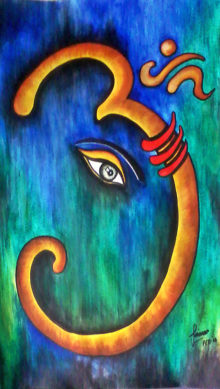 Set in his enormous head, Ganesha’s eyes are small because he has little use for them. However his third eye, the eye of intuition, is wide open, and he sees past, present, and future simultaneously. Seated as he is deep within every living and non-living entity, he sees everything. That is why he is called Adi Rishi, “the primordial seer.” He is the eternal source of knowledge – revelation flows through him. The scriptures refer to him as Parama Guru, “the master of all previous masters.”
Set in his enormous head, Ganesha’s eyes are small because he has little use for them. However his third eye, the eye of intuition, is wide open, and he sees past, present, and future simultaneously. Seated as he is deep within every living and non-living entity, he sees everything. That is why he is called Adi Rishi, “the primordial seer.” He is the eternal source of knowledge – revelation flows through him. The scriptures refer to him as Parama Guru, “the master of all previous masters.”
The scriptures identify Ganesha with the sacred sound Om, and the shape of his trunk resembles the word written in Sanskrit. Because Om is the source of all mantras, repeating any mantra is tantamount to meditating on Ganesha. All sounds, words, and mantras in their dormant form rest in the muladhara chakra, where Ganesha resides.
The most subtle, vibrationless state of sound in the muladhara chakra is called “para.” At the behest of Ganesha,who presides over gravitational energy, a stirring arises in the muladhara chakra that can be detected only intuitively. This vibrationless vibration can be felt when it reaches the navel center; when it reaches the heart center, it assimilates the power of thinking; and it becomes audible when it reaches the throat center. Ganesha oversees this entire process. Without his assistance and guidance we can neither gain access to the muladhara center nor receive the ensuing revelation.That is why Ganesha is said to be the gatekeeper at the palace of the Divine Mother.
Though Ganesha’s feet are quite small, he outruns all the forces of the universe – because he pervades everything, he is already everywhere. Without moving, the lord of gravitational energy makes everything move. With his enormous body and tiny feet Ganesha dances to the song of the Divine Mother, and exhilarated by his movements, She joins in.Then, as mother and son perform their cosmic dance, all the arts and sciences spring forth. Unable to contain the divine ecstasy, the sages emerge from their absorption in Ganesha and assume their roles as our guides.
This cosmic dance symbolizes the process of kundalini awakening. The forces of darkness can cast their spell of slumber on us only as long as we are outside the pale of this dance. Thus Ganesha, the remover of obstacles, is the one who awakens the divine force in the form of kundalini shakti. He blesses us with shaktipata (the bestowing of divine energy). It is he who sends a sat guru (a true master) into our lives, and through his grace the forces of love, compassion, self-motivation, self-confidence, and determination unfold. Thus the scriptures assert that the door to the Divine Mother’s palace opens when Ganesha is pleased.
There are hundreds of ways to propitiate Ganesha and meditate on him. The tantric method, in conjunction with yantra sadhana, is precise and methodical. Those whose prolonged practice has gained them access to the muladhara center meditate on Ganesha by practicing the tantric method of kundalini yoga. To them, the human body is a yantra. Others draw the yantra of Ganesha on a gold, silver,or copper plate, on a silk cloth, on a wooden board, or on a piece of birch bark, and meditate on that.
From: Warrior of Light (India)
Ganesh and Science
Tradition describes the entire universe as being contained in Lord Ganesha’s big belly. Thus we look upon Him as the overlord who holds sway over the material universe, the sum of cosmic mass. One of His potencies is gravity.
Gravity is a mysterious force to the scientist even today. It is the galactic glue that draws and holds larger mass together and gives order to the macrocosm. It is an instantaneous force, so that when one celestial body moves in a remote corner of a galaxy, all other masses through out the galaxy adjust simultaneously, even though it would take light, at its incredible speed, millions of years to travel the distance.
This implies that space and time are relative concepts and there is “something” that exists everywhere in the universe at once. Like gravity Lord Ganesha is totally predictable and known for orderliness. Without gravity, the known galactic systems could not exist; masses would stray apart; all organization of life as we know it would be impossible. Gravity is the basis of ordered existence in the macrocosm, and our loving Ganesha holds dominion over its mysteries.
Like gravity, Lord Ganesha is always with us, supporting and guiding our physical existence. He is a potent force in the universe, not a representation of potent universal forces. Corpulently built, Lord Ganesha is said to contain within Himself all matter, all mind. He is the very personification of material existence. We look upon this physical world as the body of Lord Ganesha.
In seeing and understanding the varied forces at work in the physical universe, we are seeing and understanding the powers and the being of Lord Ganesha. There is nothing that happens on this material plane of existence except that it is the will of God Shiva and minutely detailed by His beloved son Lord Ganesha. To Him we offer our reverent love and praise.
from Loving Ganesa
by Satguru Sivaya Subramuniyaswami
When Prayers Don’t Work
What does it mean when an obstacle is encountered despite our sincere supplication of Lord Ganesha?
It may mean that the time, the means, or the goal itself is not right for our karma and dharma. The architect presents his finished plans to the engineer. They are rejected for one technical reason or another. The executive presents a completed letter to the president. It is rejected as not being explicit enough in the third paragraph. The architect and the executive were equally sincere in presenting their work. The engineer and the president were performing their duty as well.
Lord Ganesha loves us. He is a loving God who guides, governs, and controls with speed and accuracy when the plan is perfect, deliberates long and rejects often when the plan needs revision.
Take the plan back into your mind. Search your own superconsciousness for the greater ideas, and revise your efforts with confidence. Seek for the right timing and proceed with confidence when you know the timing to be right.
“When the will rises and commands, even the Gods are willing to obey,” or to give immediate cooperation, to guide, and enhance our efforts. We must work our minds in close cooperation with the mind of Lord Ganesha, and then success is certain. Thus, this God is called Bhaktavighnavinasana, He who destroys the obstacles of the devotees.
From: Loving Ganesha
The Ganesh Oracle
Look what I found! Whispers of Lord Ganesha oracle cards. I thought they were pretty nifty, and so I went on a search to see if I could find them online to share here. I found some, but not all. So, I had this idea that we could have our own “oracle” for this project.
Here’s how it works:
I uploaded all the images I found into a gallery, and set it to display in random order. Each time the page reloads, the images should be arranged differently. So, ask the Lord Ganesha what quality, aspect, or idea he’s willing to work with you on today and reload the page. The first image in the gallery is his answer.
If you like these, you can find them at Amazon: Whispers of Lord Ganesha. They also have a journal for those of you who like journaling. The latest version of this oracle can be found at my newest little website, Loving Ganesha. Anytime I find new oracle cards, I will be adding them there.
- Radical Self Care Project Overview by shirleytwofeathers - No Comment
- Radical Self Care Image Gallery by shirleytwofeathers - No Comment
- It’s A Wrap by shirleytwofeathers - 3 Comments
- Something To Consider by shirleytwofeathers - 1 Comment
- Nurturing Your Precious Self by shirleytwofeathers - 3 Comments
me: Make Your Own Violet Fire
Abdulrahman: Money Chant – Very Fast
Shirley Twofeathers: It’s A Wrap
Daniel Knirs: It’s A Wrap
Shirley Twofeathers: It’s A Wrap
